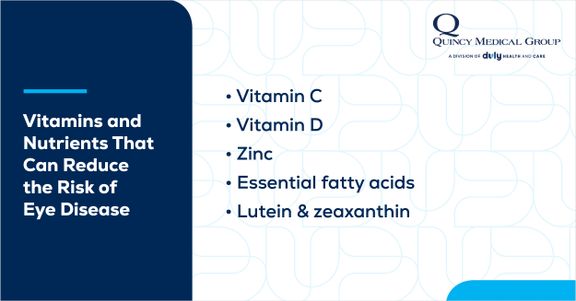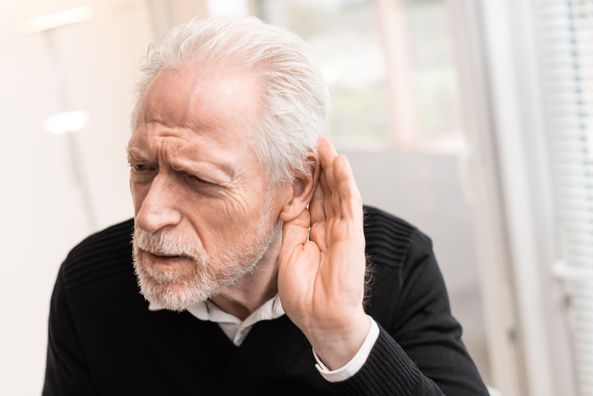Squinting a little more than usual, reaching for your glasses more often, needing to turn on “large text” mode on your phone…these are common experiences as you get older.
It’s normal for aging eyes to lead to changes in your vision. In many cases, using glasses or getting a new prescription will do the trick. But when these simple corrective measures don’t work, your vision loss may be due to a more serious eye condition.
Common Eye Problems as You Age
With age comes an increased risk for certain types of eye problems that can affect your vision.
Cataracts
The lens is a clear part of the eye just behind the iris (the colored part of the eye) that helps focus light. As you age, proteins in the lens begin to break down and form clumps. These clumps create cloudy areas in the lens called cataracts.
If you have cataracts, it can feel like you’re looking through a foggy or frosty window. In addition to blurry or dim vision, you may notice some of these symptoms:
Colors appear faded or yellowed
- Double vision in one eye
- Difficulty seeing at night
- Sunlight, lamps, or headlights appear too bright
- Seeing rings (“halos”) around lights
- Constantly needing changes to your eyeglasses or contact lens prescriptions
- Needing brighter light to read
Surgery is the only way to get rid of cataracts. Getting surgery on your eye might make you shudder to think about, but there’s no need to worry – cataract surgery is one of the most common and safest surgeries in the US. It is an outpatient procedure, meaning you can go home on the same day. The eye is numbed during the surgery, so most people feel little to no pain.
Dry Eye
Dry eye is when the tear glands in your eyes don’t work well and your eyes can’t make enough tears to stay moist. In addition to feeling dry, your eyes might feel like they are stinging, burning, or scratching, or that there is something stuck in them. It can also make your eyes red and your vision blurry or make you extra sensitive to light.
Fortunately, there are treatments to ease symptoms, such as:
Over-the-counter eye drops called “artificial tears”
- Prescription medications
- Lifestyle changes like avoiding smoking or using a humidifier
- Tear duct plugs, which keep tears in your eyes
- Therapeutic contact lenses
- In-office pulsation or light procedures
- Surgery to fix droopy eyelids (not used very often)
Age-Related Macular Degeneration (AMD)
Macular degeneration is a condition that blurs your central vision, making it difficult to clearly see objects directly in front of you. Age-related macular degeneration (AMD) is the main cause of vision loss in older adults.
With AMD, you won’t have complete blindness. However, you may have enough vision loss that it causes trouble with reading, driving, or doing close-up work like cooking.
The good news is that AMD comes in stages, and significant vision loss doesn’t generally occur until it is in its latest stages – and getting to late-stage AMD isn’t a guarantee. You might stay in the early or intermediate stages and only experience slight vision problems.
There isn’t a cure for AMD, but there are several treatments that can make symptoms less severe and slow down the progression of the disease. Your provider may recommend taking certain medications or nutritional supplements or trying a laser therapy treatment.
Also read: What is Age-Related Macular Degeneration?
Glaucoma
Glaucoma is a catch-all term for several diseases that cause pressure to build up in your eyeball. That pressure damages the optic nerve at the back of your eye, which can lead to blindness. In fact, glaucoma is one of the leading causes of blindness.
When it starts, glaucoma doesn’t cause any symptoms. But as the disease gets worse, you might notice symptoms like eye pain or pressure, blurry or low vision, blind spots, double vision, headaches, or red or bloodshot eyes.
Damage caused by glaucoma is permanent and can’t be reversed – however, there is good news. Treatments like surgery, medication, or laser therapy can help slow down glaucoma and prevent vision loss. The earlier you start these treatments, the better chance you have of keeping vision loss at bay.
Also read: New Technology at QMG Provides Early Detection of Eye Diseases
Diabetic Retinopathy
Diabetes can block the blood vessels that go to the retina (the part of your eye that detects light and sends signals to the brain). Your eyes then grow new blood vessels to make up for it. However, the new vessels can easily bleed or leak fluid. As the condition progresses, you may notice spots floating in your vision (floaters), blurred vision, or vision loss.
Anyone with diabetes can develop diabetic retinopathy. However, it may be seen more in older adults because the risk increases the longer you have had diabetes.
If you have diabetes, you won’t necessarily develop diabetic retinopathy. And while it’s not always preventable, you can lower your risk by managing your diabetes and keeping your blood pressure and cholesterol at healthy levels.
Early diabetic retinopathy typically doesn’t need to be treated. In the later stages, you may need medication injections, laser therapy, or surgery. These treatments can’t cure diabetic retinopathy, but they can slow it down or stop it from progressing.
How to Protect Your Eyes as You Age
As you get older, it’s extra important to take care of your aging eyes. Some ways to do this include:
Stopping smoking
- Maintaining normal blood pressure
- Being physically active
- Staying at a healthy weight
- Wearing protective gear when in the sun, like sunglasses that block ultraviolet radiation and a wide-brimmed hat
- Managing diabetes
- Taking breaks from looking at your computer every 20 minutes
- Eating a diet rich in vitamins and nutrients that improve eye health

Vitamins and Nutrients That Can Reduce the Risk of Eye Disease
Vitamin C
Vitamin D
Zinc
Essential fatty acids
Lutein & zeaxanthin
Also, have your eye health monitored on a regular basis. It’s recommended that adults over 65 get a comprehensive eye exam every 1 to 2 years. If you already have an eye condition or diabetes, your provider may suggest testing more often.
Also read: Tips to Reduce Eye Strain
Even with the best preventive measures, age can take a toll on your vision. But with early diagnosis, the right treatment, and taking care of your overall health, you may be able to lower your risk of severe vision problems.
Have you had your regular comprehensive eye exam? Schedule an appointment with a Quincy Medical Group optometrist.
Health Topics:






